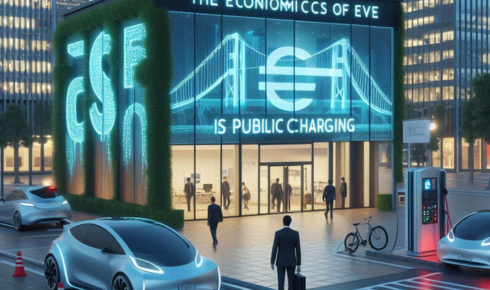
EVSE
The electric vehicle (EV) industry is expanding rapidly, and with it, the demand for EVSE (Electric Vehicle Supply Equipment) is growing. While home charging remains the most convenient option for many EV owners, public charging infrastructure is essential for long-distance travel, urban dwellers without private parking, and fleet operations.
However, a key question remains: Is public EV charging a profitable business? With high infrastructure costs, fluctuating electricity prices, and evolving technology, investors and businesses must carefully evaluate the economics of EVSE before entering the market.
In this article, we will explore the financial aspects of public EV charging, key revenue models, and how companies like GONEO are providing innovative solutions to make public EVSE more profitable.
1. The Costs of Public EV Charging Infrastructure
Before discussing profits, it’s crucial to understand the costs involved in setting up and operating an EVSE business.
1.1. Initial Investment Costs
Setting up a public EV charging station involves:
- Land acquisition or leasing fees (if not using existing parking lots).
- Hardware costs (chargers, transformers, power distribution units).
- Installation expenses (wiring, trenching, labor).
- Grid connection upgrades (especially for fast chargers).
For example, a Level 2 charger typically costs $2,000–$5,000 per unit, whereas a DC fast charger (DCFC) can range from $30,000 to $150,000 per unit—excluding installation and grid connection fees.
1.2. Operational Costs
Once installed, a charging station has recurring expenses:
- Electricity costs (varies by location and time of use).
- Maintenance and repairs (cables, connectors, software updates).
- Networking fees (for payment processing and software management).
- Customer service and support.
To optimize costs, GONEO offers smart EVSE solutions that use dynamic pricing, energy load balancing, and AI-driven efficiency management, helping businesses reduce operational expenses and maximize revenue.
2. Revenue Streams for Public EVSE Businesses
Despite the high upfront costs, public charging can be profitable if structured correctly. Here are the main ways EVSE operators generate revenue:
2.1. Charging Fees
Most public charging stations operate on a pay-per-use model, where customers are charged:
- Per kWh of electricity used (e.g., $0.25–$0.50 per kWh).
- Per minute of charging (common for fast chargers).
- Flat session fees (e.g., $5 per charge).
With GONEO’s AI-powered pricing system, operators can implement dynamic pricing, adjusting fees based on demand, peak hours, and local electricity rates to maximize profits while keeping customers satisfied.
2.2. Subscription & Membership Plans
Some EVSE providers offer subscription-based charging, where users pay a monthly fee for unlimited or discounted charging.
For example, a driver might pay $20 per month for unlimited access to a specific network. This model provides:
✅ Predictable revenue for operators.
✅ Loyalty incentives for customers.
GONEO’s cloud-based EVSE management software enables charging station owners to offer customizable membership plans, increasing customer retention and profitability.
2.3. Government Incentives & Carbon Credits
Many governments provide grants, tax credits, and rebates for businesses investing in EVSE. Additionally, operators can earn revenue through:
- Low Carbon Fuel Standards (LCFS) credits, where EVSE owners sell carbon credits to companies needing offsets.
- Utility partnerships, where grid operators pay charging stations to balance electricity demand during peak hours.
By integrating smart energy management systems, GONEO helps EVSE operators optimize energy usage, making them eligible for additional incentives and credits.
2.4. Advertising & Partnerships
EV charging stations are valuable real estate for advertising. Operators can:
- Sell digital ad space on charging station screens.
- Partner with retail stores and restaurants to drive customer traffic.
- Offer sponsored branding opportunities on the EVSE network.
Some businesses even provide free or discounted charging in exchange for increased customer visits. GONEO’s smart charging stations support integrated advertising displays, allowing operators to generate additional revenue.
3. Key Challenges to Profitability
Despite multiple revenue streams, profitability in the EVSE business is not guaranteed. Here are some key challenges:
3.1. High Electricity Costs & Demand Charges
Electricity costs are a major factor in EVSE profitability, especially for fast chargers that require high power levels.
Many utilities impose demand charges, where businesses pay extra fees for high electricity consumption during peak hours. In some cases, demand charges can make DC fast charging unprofitable unless managed properly.
GONEO’s energy management platform helps charging station operators:
✅ Optimize charging times to avoid peak electricity rates.
✅ Use battery storage solutions to reduce demand charges.
✅ Integrate with renewable energy sources for cost savings.
3.2. Utilization Rates & Location Strategy
A charging station needs high utilization rates to be profitable. A common industry benchmark is a 20-30% utilization rate (meaning chargers are in use 20-30% of the time).
To maximize profitability, GONEO provides location analysis tools, helping businesses select high-traffic areas with strong customer demand.
3.3. Competition & Pricing Pressure
As more companies enter the EVSE market, competition is increasing, leading to price wars and lower margins.
To differentiate themselves, successful charging networks:
✅ Offer value-added services (like WiFi, lounges, or EV concierge services).
✅ Invest in branding and customer loyalty programs.
✅ Provide faster charging speeds and premium locations.
GONEO’s advanced software solutions enable operators to create custom user experiences, making their charging stations more attractive to customers.
4. Conclusion: Can Public EV Charging Be Profitable?
The profitability of public EVSE depends on location, pricing strategy, energy management, and customer engagement. While high upfront costs and operational expenses pose challenges, companies that leverage smart charging solutions, dynamic pricing, and multiple revenue streams can achieve long-term success.
Why GONEO Is a Game-Changer for EVSE Profitability
GONEO provides cutting-edge smart EVSE solutions that help businesses:
✅ Reduce operational costs with AI-powered energy management.
✅ Maximize revenue through dynamic pricing and membership models.
✅ Leverage advertising, partnerships, and incentives for additional income.
✅ Improve utilization rates with data-driven location analytics.
As the EV market continues to grow, investing in smart, well-managed EVSE infrastructure will become increasingly profitable. With the right technology—such as GONEO’s intelligent charging solutions—businesses can turn public EV charging into a lucrative and sustainable venture.






